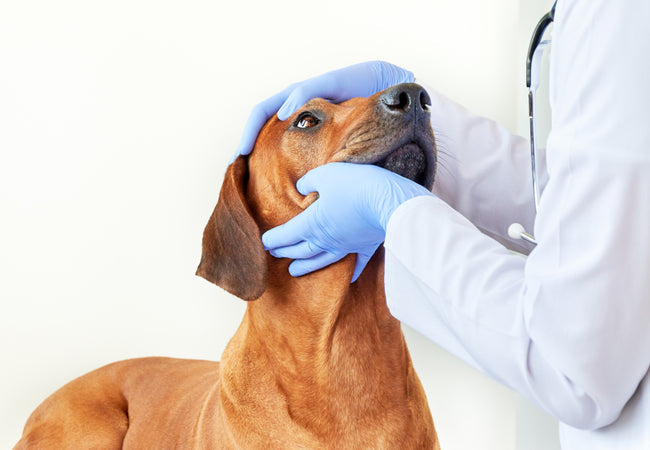Entropion in Dogs 2025: In‑Depth Veterinary Guide 🩺🐾

In this article
Entropion in Dogs 2025: In‑Depth Veterinary Guide 🩺🐾
By Dr. Duncan Houston BVSc
Hi, I’m Dr Duncan Houston BVSc, veterinarian and founder of Ask A Vet. Entropion is a painful eye condition where the eyelid rolls inward, causing eyelashes to rub the cornea. In 2025, we will have improved diagnostic tools, surgical techniques, and recovery protocols to help dogs heal comfortably and see clearly again. This guide dives into types, causes, symptoms, diagnosis, treatments including temporary tacking vs permanent Blepharoplasty post-operative recovery, prognosis, and how Ask A Vet supports pet parents every step of the way. Let’s give those eyes the care they deserve! 🐶💙
1. 🔍 What Is Entropion?
Entropion is an eyelid abnormality where one or both eyelids (upper or lower) roll inward, causing hair and eyelashes to rub against the cornea. This leads to discomfort, excessive tearing, corneal ulcers, infections, and even scarring or vision loss.
2. 😢 Types of Entropion & Causes
- Inherited/developmental entropion: Present in breeds with excessive facial skin or droopy lids; often seen in young, rapidly growing dogs and common in Shar‑Peis, Chow Chows, Pugs, Bulldogs, Mastiffs, and Bloodhounds.
- Spastic entropion: A reflexive lens tightening response to ocular pain (ulcers, uveitis), often reversible with treatment of the underlying eye condition.
- Acquired entropion: Results from eyelid scarring, trauma, muscle weakness, or globe shrinkage (e.g., post-end‑stage glaucoma), mostly in older dogs.
3. 👁️🗨️ Who's at Risk? Breed Predispositions & Age
Entropion typically appears before a dog reaches one year of age, though spastic or acquired forms can affect any age. Inherited cases are common in breeds like Shar‑Pei, Chow Chow, Neapolitan Mastiff, Bullmastiff, Saint Bernard, Bloodhound, Rottweiler, Labrador, Great Dane, Pug, and others. Flat-faced (brachycephalic) dogs may not show obvious pain, yet still suffer from photo-sensitivity, tear staining, and pigmentary keratitis.
4. ⚠️ Signs & Symptoms to Watch For
Typical clinical signs include:
- Inward-rolled eyelids are visible on exam
- 🔴 Squinting/blepharospasm and light sensitivity
- 💧 Excessive tearing (epiphora), mucous discharge
- 👃 Rubbing paws or furniture to scratch eye
- 👁️ Redness, conjunctivitis, corneal ulcers, or pigment
- 🌫️ Corneal opacity is visible with fluorescein stain
Flat-faced breeds may not exhibit overt pain but still sustain chronic damage.
5. 🧪 Diagnosis & Assessment Methods
- Physical exam: Observation of eyelid position, blink reflex, and hair contact with cornea.
- Fluorescein stain test: Detects corneal ulcers and damage from eyelid rubbing.
- Schirmer tear test: Measures tear production if concurrent dry eye is suspected.
- Eye pressure/go, globe size: Evaluated to rule out glaucoma or enophthalmos.
- Breed history and growth status: Important in timing treatment between temporary and permanent fix.
6. 🛠️ Treatment Options: Temporary vs Permanent
6.1 Temporary Tacking in Puppies
- Pretacks eyelids outward using mattress sutures until puppy’s facial structures mature (~2‑4 weeks).
- Successful in ~36–40 % of cases, especially when done early.
- Allows assessment of the need for subsequent permanent surgery.
6.2 Surgical Correction – Blepharoplasty (Hotz‑Celsus)
- Definitive treatment involves wedge- or spindle-shaped skin excision and eyelid margin repositioning under general anesthesia.
- #Minimally invasive versions: wedge resection, lateral or medial canthoplasty tailored by breed and lid location.
- Often requires a two-stage procedure to carefully match the eyelid contour.
- Success rate >95 %, though occasional under‑ or over‑correction may occur, requiring follow-up surgery.
- Surgery is safe to perform in juveniles (<1 year) with similar outcomes to adults.
Additional Non‑Surgical Option: Hyaluronic Acid Injections
- Temporary eyelid plumping via HA substances in dogs with high anesthesia risk, even under minimal sedation.
- Provides short‑term relief while planning more permanent correction.
7. 🏥 Surgery Day & Recovery Protocol
- Preparation: Pre-anesthetic bloodwork, stoppage of eyelicking, and fasting.
- Anesthesia & sterile prep: General anesthesia, aseptic eyelid prep.
- Surgery: Precise tissue removal and eyelid repositioning.
- Post‑op meds: Topical antibiotics, anti-inflammatories, and pain relief; Elizabethan collar applied.
- Activity restriction: Minimal activity, indoor confinement, avoid irritation for 10–14 days.
- Follow-up: Recheck in 10–14 days for suture removal and sign-of-life exam.
8. 📈 Prognosis & Long‑Term Outlook
- Generally excellent prognosis when treated early—permanent relief in >95 % of cases.
- Even juvenile surgery gives a similar recurrence rate as adults (~8–13 %).
- If corneal scarring or vision loss occurs before surgery, some damage may be irreversible.
- Owners should monitor for recurrence, especially during growth or seasonal changes, using wellness checks and follow-up.
- Breeding dogs with entropion is discouraged due to its heritable nature.
9. 🧩 Tools & Support: Ask A Vet Integration
- Ask A Vet: Tele-consults for diagnosing, monitoring, post-op guidance, and recurrence checks.
10. 📝 Closing Thoughts
Entropion is a painful but treatable condition. Thanks to improved veterinary ophthalmic techniques in 2025, most dogs recover fully and regain comfort and vision. By using early intervention, performing appropriate temporary or permanent corrections, and integrating telehealth and wellness tracking through Ask A Vet, we can ensure the best outcomes for our faithful companions. If you suspect entropion—or just want a proactive eye check—book an appointment early. Happy, healthy eyes lead to happy dogs! 🐾💙






